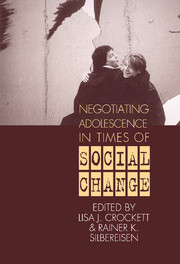Book contents
- Frontmatter
- Contents
- Contributors
- Preface
- 1 Social Change and Adolescent Development: Issues and Challenges
- Part I Models of Social Change Effects
- Part II Social Change and Adolescent Transitions
- Part III Social Change and Adolescents' Social Contexts
- Part IV Implications of Social Change for Adolescent Health and Well-Being
- Part V Interventions: Promoting Healthy Development in Times of Social Change
- Endnotes
- Index
1 - Social Change and Adolescent Development: Issues and Challenges
Published online by Cambridge University Press: 26 January 2010
- Frontmatter
- Contents
- Contributors
- Preface
- 1 Social Change and Adolescent Development: Issues and Challenges
- Part I Models of Social Change Effects
- Part II Social Change and Adolescent Transitions
- Part III Social Change and Adolescents' Social Contexts
- Part IV Implications of Social Change for Adolescent Health and Well-Being
- Part V Interventions: Promoting Healthy Development in Times of Social Change
- Endnotes
- Index
Summary
Like other phases of the life span, adolescence is shaped by the sociocultural context in which it occurs. The skills young people are expected to master, the kinds of choices they must make, and the settings they negotiate during the adolescent years are prescribed by social institutions (e.g., the educational system) and by shared expectations concerning the requirements for success in adulthood (Crockett, 1997). Social change, which entails large-scale alterations in ideological, technological, and economic systems within societies, has significant implications for adolescent development. For example, social change can affect the structure and dynamics of social contexts that adolescents experience on a daily basis such as family, school, and youth groups. It can also alter the social institutions and cultural belief systems that organize the adolescent period.
Social change has diverse origins. In some cases, change is spurred by pivotal historical events that can abruptly alter the opportunity matrix for young people's development. Examples include political revolutions such as the break-up of the former Eastern bloc, ethnic conflicts as exemplified in the Balkans, immigration, religious movements such as the fundamentalist upsurge in several Islamic countries, and technological breakthroughs that reorient large segments of the economy. In other cases, changes in social organization occur more gradually as with the post–World War II increase in women's labor force participation, the recent rise in divorce, and the growing proportion of elderly in many industrialized countries.
- Type
- Chapter
- Information
- Negotiating Adolescence in Times of Social Change , pp. 1 - 14Publisher: Cambridge University PressPrint publication year: 1999



